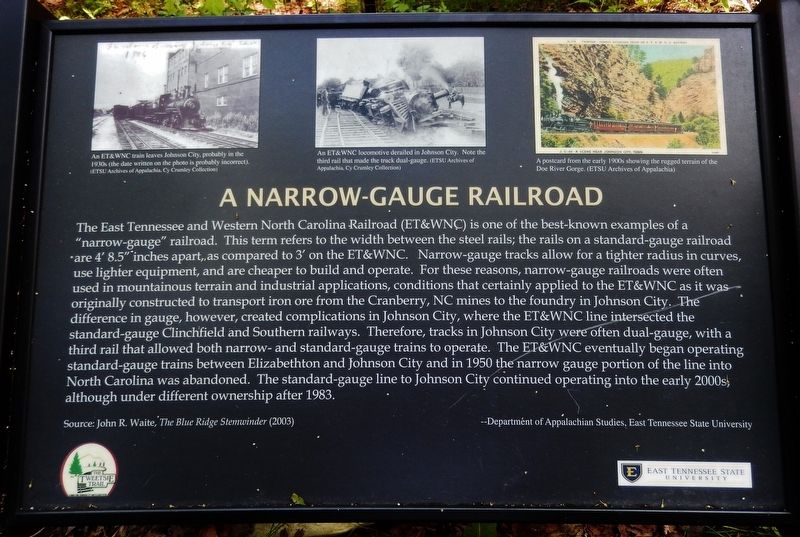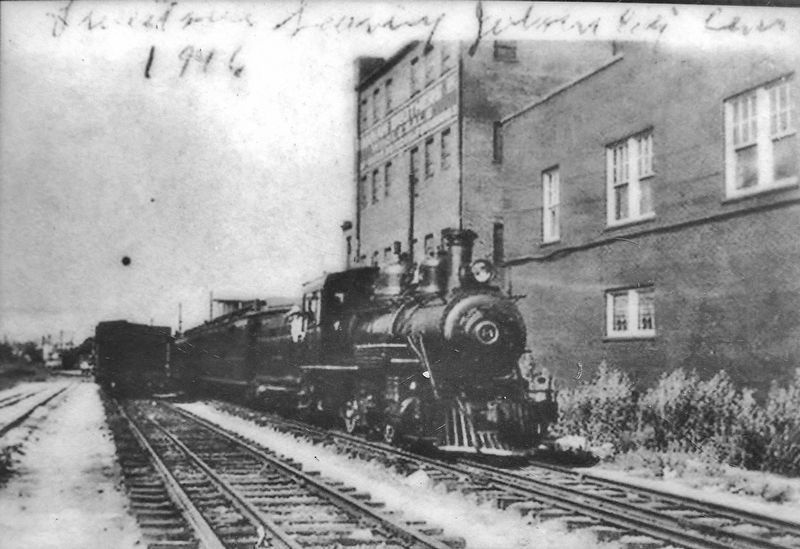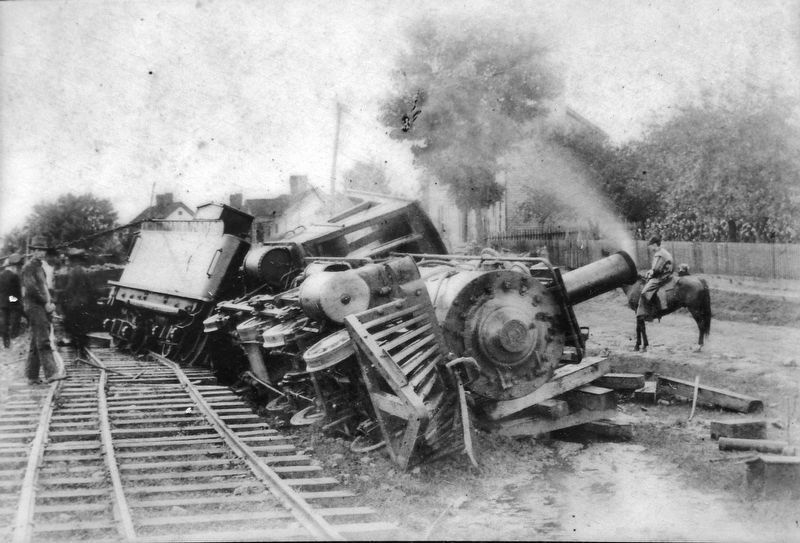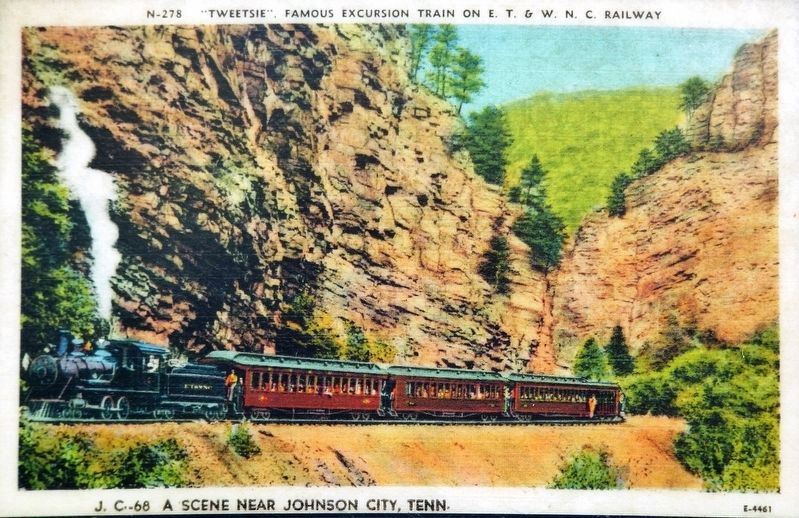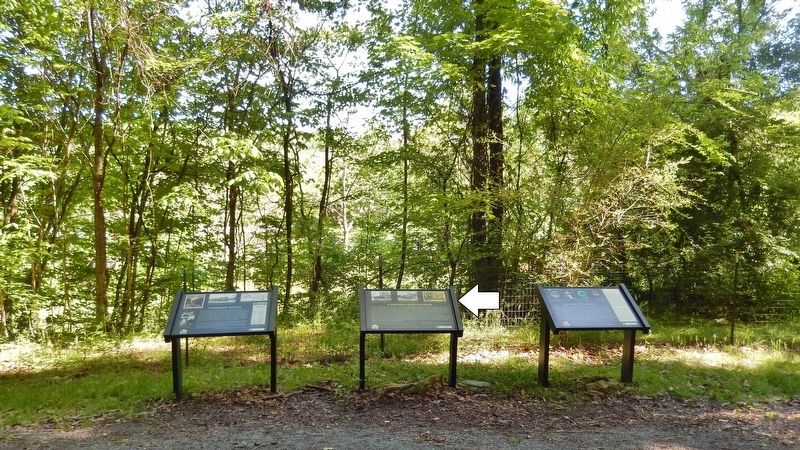Johnson City in Washington County, Tennessee — The American South (East South Central)
A Narrow-Gauge Railroad
The East Tennessee and Western North Carolina Railroad (ET&WNC) is one of the best-known examples of a "narrow-gauge" railroad. This term refers to the width between the steel rails; the rails on a standard-gauge railroad are 4' 8.5" inches apart, as compared to 3' on the ET&WNC. Narrow-gauge tracks allow for a tighter radius in curves, use lighter equipment, and are cheaper to build and operate. For these reasons, narrow-gauge railroads were often used in mountainous terrain and industrial applications, conditions that certainly applied to the ET&WNC as it was originally constructed to transport iron ore from the Cranberry, NC mines to the foundry in Johnson City. The difference in gauge, however, created complications in Johnson City, where the ET&WNC line intersected the standard-gauge Clinchfield and Southern railways. Therefore, tracks in Johnson City were often dual-gauge, with a third rail that allowed both narrow- and standard-gauge trains to operate. The ET&WNC eventually began operating standard-gauge trains between Elizabethton and Johnson City and in 1950 the narrow gauge portion of the line into North Carolina was abandoned. The standard-gauge line to Johnson City continued operating into the early 2000s; although under different ownership after 1983.
Source: John R. Waite, The Blue Ridge Stemwinder (2003)
—Department of Appalachian Studies, East Tennessee State University
Erected by Department of Appalachian Studies, East Tennessee State University.
Topics. This historical marker is listed in these topic lists: Industry & Commerce • Railroads & Streetcars.
Location. 36° 18.684′ N, 82° 19.568′ W. Marker is in Johnson City, Tennessee, in Washington County. Marker can be reached from the intersection of Alabama Street and Legion Street. Marker is located on the Tweetsie Trail, 7/10 mile east of the Johnson City Trailhead. Touch for map. Marker is in this post office area: Johnson City TN 37601, United States of America. Touch for directions.
Other nearby markers. At least 8 other markers are within 2 miles of this marker, measured as the crow flies. Passenger Service (here, next to this marker); The Music of the Rails (here, next to this marker); The Robertson Home, Site of First Court of Washington County (approx. 0.4 miles away); First Court of Washington County (approx. 0.4 miles away); Trail Geology (approx. 0.6 miles away); Story of the Tweetsie (approx. 0.6 miles away); Robins’ Roost (approx. one mile away); Tipton-Haynes Cemetery (approx. 1.1 miles away). Touch for a list and map of all markers in Johnson City.
More about this marker. Access to this marker is via bicycle or foot on the Tweetsie
Trail.
Also see . . . East Tennessee & Western North Carolina Railroad. The most formidable obstacle to be overcome was, of course, the Blue Ridge Mountains, which no other railroad had yet been successful. From Hampton, Tennessee to Cranberry, North Carolina, the railroad climbed over 1,500 feet in elevation. In 1881, the line was finished from Johnson City, Tennessee to Cranberry, North Carolina, and construction costs exceeded $1 million. The line was officially opened on July 3, 1882, with mixed passenger and freight traffic. In 1904, the railroad completed a section of track between Johnson City and Elizabethton that was dual gauge. (Submitted on October 17, 2021, by Cosmos Mariner of Cape Canaveral, Florida.)
Credits. This page was last revised on October 17, 2021. It was originally submitted on October 17, 2021, by Cosmos Mariner of Cape Canaveral, Florida. This page has been viewed 314 times since then and 41 times this year. Photos: 1, 2, 3, 4, 5. submitted on October 17, 2021, by Cosmos Mariner of Cape Canaveral, Florida.
